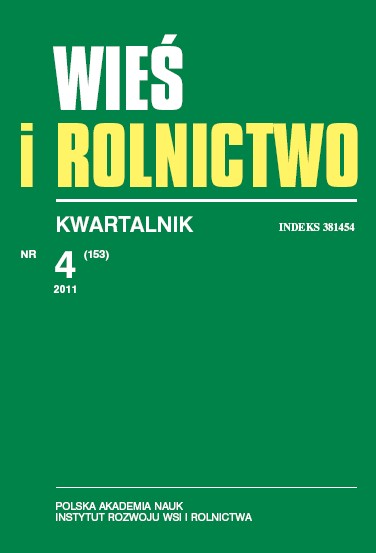Cattle in the Polish Carpathians – spatial differences and dynamics of changes
DOI:
https://doi.org/10.53098/wir.2011.4.153/12Keywords:
cattle, agricultural farm, the Carpathian Mountains, the cattle population, cattle herdAbstract
The paper deals with the problems of concentration and suspension of cattle breeding activity on farms located in the Carpathian region o Poland. The main purpose of the conducted investigations was to delimit the areas of the Carpathian region in accordance with changes in the scale of cattle production recorded in the period between 2004 and 2009. Basing on the data from the Agency for Restructuring and Modernization of Agriculture (AriMR) an analysis of changes in the number of cattle and cattle herds kept in individual communes was conducted. Prospects for cattle breeding on farms located in the Carpathian region were also discussed in the light of changes in CAP. The results of the conducted research show that in all communes of the region a decline occurred in the number of cattle herds and, consequently, in the number of cattle during the analyzed period. The decline was particularly steep in the mountainous and foothill areas of the Podkarpackie province. In 2004-2009 the number of cattle diminished by 15.6% and the number of herds by 26,6%. These figures can be interpreted as an expression of the process of economic-organizational concentration (growth in the number of animals forming a herd mainly). Unfortunately, the process of the concentration of production is slower than the process of withdrawal of farms from cattle breeding, which may have negative consequences for the landscape of the Carpathian Mountains.References
II Regulacja rynku mleka we Wspólnocie, 2009. W: Rynek mleka. Stan i perspektywy. IERiGŻ-PIB, Warszawa.
Chmielewska-Gill W.: Wspólna Polityka Rolna po roku 2013 (http://www.fapa.com.pl/gfx/saepr/WPR%20po%202013-raport%2003-09.pdf, 13.07.2011).
Kautz S., 2009: Szarże na marże. „Hodowla i Chów Bydła” 7–8: 8.
Koszty WPR, 2010 (http://ec.europa.eu/agricultur, 13.07.2010).
Murawski M., 2009: Stanowisko Polski w sprawie uwolnienia kwot mlecznych w UE po 2015 roku. „Przegląd Mleczarski” 3: 20–21.
Musiał W., 2008: Ekonomiczne i społeczne problemy rozwoju obszarów wiejskich Karpat Polskich. IRWiR PAN, Warszawa.
Nitecka E., 2009: Polskie mleczarstwo na progu 2009 roku – przewidywane zmiany uwarunkowań. „Przegląd Mleczarski” 3: 22–23.
Nowak W., Mikuła R., 2008: Wątroba najważniejsza. „Hoduj z głową. Bydło” 2: 14. DOI: https://doi.org/10.33141/po.2008.10.05
Pawlak H., 2008: Jak dawniej w Polsce bydło chowano. „Hodowla i Chów Bydła” 6: 21–23.
Rymanowski P., 2009: Mleczarstwo a marże sieci handlowych. „Przegląd Mleczarski” 7: 20–21.
Seremak-Bulge J., 2008: Polski rynek mleczarski na tle świata. „Przegląd Mleczarski” 11: 18–22.
Sitnicki S., 1986: Przyrodnicze uwarunkowania rozwoju. Szkoła Główna Planowania i Statystyki, Warszawa.
Stulich R., 2009: Rolnictwo i przemysł rolno-spożywczy po 4 latach członkostwa Polski w UE. „Przegląd Mleczarski” 2: 18–21.
Szarek J., Szulc T., Żukowski K., 2009: Historia wystaw polskiego bydła czerwonego w Polsce Południowej. „Bydło” 3: 45–47.
Downloads
Article file downloads
Pages
How to Cite
Issue
Section
License
Copyright (c) 2011 Wieś i Rolnictwo

This work is licensed under a Creative Commons Attribution 4.0 International License.










